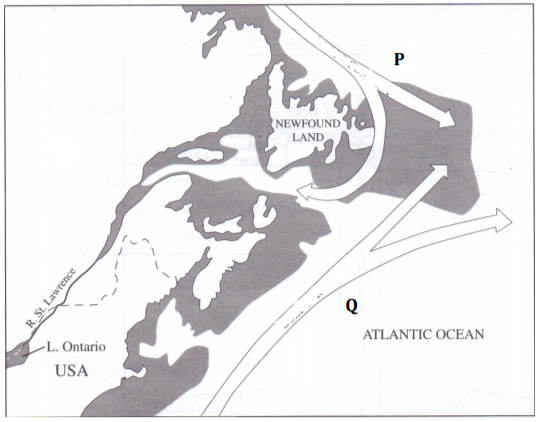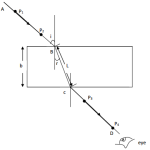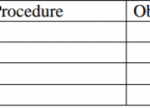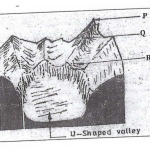KNEC Geography Paper 2 Question Paper / 2016 KCSE MOKASA Joint Examination
2016 KCSE MOKASA Joint Examination
Geography Paper 2
SECTION A (25 Marks)
Answer all the questions in this section.
(a) Give two uses of soda ash. (2 marks)
(b) State three ways in which mining derelicts can be rehabilitated. (3 marks)
5 marks
(a) Name two crops grown in Perkerra irrigation scheme. (2 marks)
(b) State three physical factors that favoured the location of Mwea Tebere irrigation
scheme. (3 marks)
5 marks
(a) Name two exotic breeds of dairy cattle reared in Kenya. (2 marks)
(b) State three factors that favour dairy farming in Denmark. (3 marks)
5 marks
(a) Define wildlife. (2 marks)
(b) State three reasons why it is necessary to conserve wildlife in Kenya. (3 marks)
5 marks
Study the sketch map of Lake Victoria below and use it to answer question (a).
(a) Name the lake parts M, N and P. (3 marks)
(b) State two advantages of using water transport. (2 marks)
5 marks
SECTION B (55 Marks)
Answer question 6 and any other TWO questions from this section
Study the photograph below and answer question (a).
(a) (i) Identify the type of photograph shown above. (1 mark)
(ii) Draw a rectangle measuring 15cm by 10cm to represent the area covered
by the photograph. (1 mark)
(iii) On the rectangle, sketch and label four main features shown on the
photograph. (4 marks)
(iv) Describe the nature of the landscape of the are represented by the
photograph. (3 marks)
(b) Give three physical conditions that favour coffee growing in Kenya.
(3 marks)
(c) Explain three problems facing coffee in Kenya. (6 marks)
(d) Compare coffee growing in Kenya and Brazil under the following sub-headings.
• Coffee growing areas. (2 marks)
• Soil (2 marks)
• Labour (2 marks)
25 marks
(a) (i) What is agro forestry? (2 marks)
(ii) Differentiate between indigenous and exotic forests. (2 marks)
(iii) Name two indigenous softwood trees species. (2 marks)
(b) (i) Explain three factors that favour the growth of natural forests on the
slopes of Mt. Kenya. (6 marks)
(ii) State four factors that have led to the reduction of the area under forest
on the slope of Mt. Kenya. (4 marks)
(c) Give differences in the exploitation of softwood forests in Kenya and Canada
under the following headings.
(i) Tree species (2 marks)
(ii) Problems facing forestry. (2 marks)
(d) Form four students in a school carried out a field study on forestry within
their county.
(i) Give three reasons why a recconnaince was necessary for field study.
(3 marks)
25 marks
(a) Define the term fishing. (2 marks)
(b) (i) Name two types of marine fish caught along the East African coast.
(2 marks)
(c) Use the map of North-West Atlantic fishing ground to answer questions c(i).

(i) Name the ocean currents marked P and Q. (2 marks)
(ii) Explain three ways in which the convergence of ocean currents marked
P and Q influence fishing. (6 marks)
(d) (i) Describe how drifting method is used in fishing. (5 marks)
(ii) State three factors which are considered when choosing a fishing
method. (3 marks)
(iii) State three problems which face fishing in Lake Turkana. (3 marks)
(e) State two reasons why fish farming should be encouraged in Kenya.
(2 marks)
25 marks
(a) (i) Give two renewable sources of energy. (2 marks)
(ii) State two advantages of using uranium as a source of energy.
(2 marks)
(b) (i) Apart from generating H.E.P, give three other benefits that have resulted
from the construction of Masinga Dam. (3 marks)
(ii) Explain four physical factors that influence the location of a hydro-
electric power station. (8 marks)
(c) State two conditions necessary for the formation of petroleum. (2 marks)
(d) Explain four effects that the increase in oil prices has had on the economy of
Kenya. (8 marks)
25 marks
(a) (i) Distinguish between industry and industrialization. (2 marks)
(ii) State five factors that have influenced industrial development in Thika.
(5 marks)
(b) (i) Explain three reasons a government may have for influencing industrial
location. (6 marks)
(ii) Explain four factors that have led to the rapid development of
automobile industries in Japan. (8 marks)
25 marks







